BiHelix: A Must-See Overview of RGB Ecological Projects
Author: Echo, BiHelix
Introduction
The RGB protocol stands for "Really good for Bitcoin," and its initial goal was to improve colored coins. It is a second layer (L2) and third layer (L3) protocol based on smart contracts, built on the Bitcoin base layer (LNP/BP) and the Lightning Network, aimed at expanding Bitcoin transactions and providing enhanced transaction privacy.
RGB was initially proposed by Peter Todd and Giacomo Zucco in 2016. Since mid-2019, the main contributors to the project have been Dr. Maxim Orlovsky and Pandora Core AG. Based on the standards established by Dr. Orlovsky and Dr. Zucco in 2019 through the Swiss non-profit organization LNP/BP Standards Association, the RGB protocol was launched on the mainnet in June 2023.
Like Ethereum, the RGB protocol is a Turing-complete smart contract platform based on Bitcoin. This means developers can build complex smart contracts, enabling the issuance of fungible and non-fungible tokens, as well as the creation of decentralized applications (dApps) and decentralized autonomous organizations (DAOs). This article will begin to outline representative projects in various promising segments based on the RGB protocol.
DAO------LNP/BP Association
LNP/BP stands for "Bitcoin Protocol/Lightning Network Protocol," and the core team of the RGB protocol has established a non-profit organization based on this protocol—LNP/BP Association, responsible for overseeing the development of Bitcoin across layers. The mission of the association is to standardize the creation and maintenance of standards, develop libraries, nodes, and tools, and implement open-source references; conduct community education to ensure community values remain aligned. The values of the association include resisting censorship, privacy, and layering.
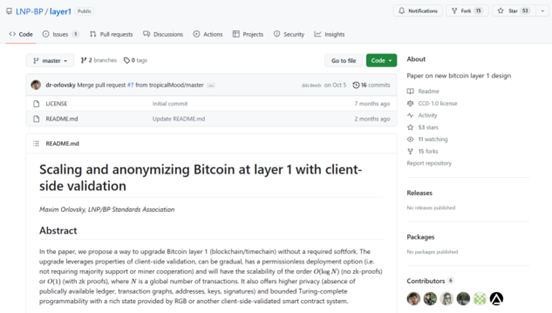
The LNP/BP Association's products cover three main verticals:
- Bitcoin Protocol (BP);
- Client validation enhancements for Bitcoin components, Lightning Network Protocol (LNP);
- Generalization of the Lightning Network with advanced features, smart contracts (such as RGB), enabling programmable client validation.
Currently, the only official way to join is through------contribution support, which allows any for-profit company, non-profit organization, DAO, or individual to become a member of the association. Any entity or individual wishing to become a member should make contributions that may include financial support, as well as contributions to the association's projects, standards, and designs.
https://www.lnp-bp.org/
NFT(UDA) MarketPlace - DIBA
Although NFTs became a focal point at the end of 2020, many are not familiar with the origins of artworks and assets on the blockchain that started with Bitcoin—from the 2011 "Message from the Mines" to the "Colored Coins Proposal," it can be said that Bitcoin is the beginning of all NFT technologies.
DIBA is the first marketplace to create, collect, and trade NFTs directly on Bitcoin using the UTXO model and the RGB protocol (Bitcoin smart contract protocol), building decentralized applications on Bitcoin and the Lightning Network. Founder Gideon Nweze stated, "Bitcoin art is a Trojan horse that will bring real utility to the future financial system… it will drive the mass adoption of censorship-resistant digital property. When we build the future in a decentralized, transparent, and honest way, art will be the common ground for everyone around the world."
Artists can create digital assets on Bitcoin through DIBA. "The use of art as a key to transformation and adoption is a well-known movement, and I believe that in the future, everyone will have equal opportunities to own valuable unique digital assets while participating in economic activities by running their own Lightning nodes," said Gideon Nweze.
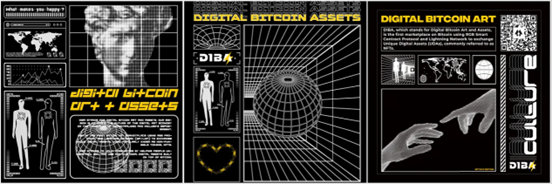
The DIBA ecosystem allows users to collect digital artists directly bound to Bitcoin UTXOs (unspent transaction outputs) using the client-validated smart contract system of RGB through a tokenless Bitcoin layer 2 scaling solution. The DIBA ecosystem is contributed by the LNP/BP Standards Association and Dr. Maxim Orlovsky and Dr. Olga Ukolova (Pandora Core) in collaboration with the organization.
All digital assets accept the version after the Taproot upgrade (the Taproot upgrade is the most significant upgrade to the Bitcoin network since 2017, enhancing Bitcoin's privacy, smart contract capabilities, and reducing transaction costs).
https://diba.io/
Infrastructure - BiHelix
In a private email conversation with members of the Bitcoin community in 2010, Satoshi Nakamoto wrote, "I am very sure that in 20 years, Bitcoin will either achieve complete large-scale application or have zero transaction volume."
BiHelix is a Bitcoin ecological infrastructure based on the native Bitcoin blockchain, combining the RGB protocol and the Lightning Network to build optimized nodes. Aiming to achieve large-scale application of Bitcoin, BiHelix introduces business models and incentive mechanisms for RGB through the Lightning Network, promoting the engineering implementation of the RGB protocol by building a Turing-complete application ecological network. By establishing a smart contract platform, it addresses the long-standing "non-Turing complete" issue of Bitcoin scripts, thereby enabling more applications to run on the Bitcoin blockchain. As the first infrastructure built on the RGB protocol, it aims to create a fairer decentralized crypto world for miners, validators, node service providers, exchanges, and users.
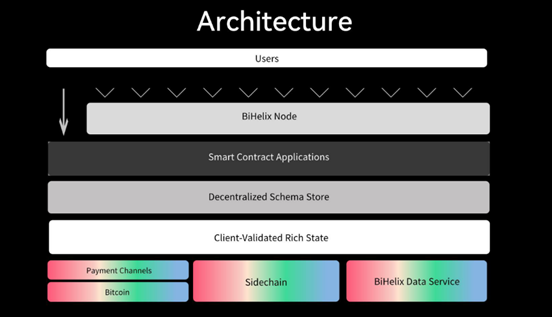
Implementation methods:
- Optimize the RGB protocol for better compatibility with the Lightning Network, thereby increasing the scalability of the Bitcoin blockchain.
- Utilize native economic incentives and business to attract miners and developers to develop smart contracts on BiHelix.
- Optimize the connection between RZK (recursive zero-knowledge), storage, communication, and other protocols with the RGB protocol to create a complete underlying ecology.
https://linktr.ee/bihelix
Wallet - Bitmask
BitMask is an open-source, multi-signature Bitcoin wallet that emphasizes privacy, security, and decentralization. It allows users to retain control over their private keys while still enjoying the convenience of a web wallet.
Main features:
- Multi-signature security - BitMask uses a 2-of-3 multi-signature setup. Transactions require 2 signatures to be valid, protecting funds in case one of the keys is compromised.
- Hierarchical Deterministic (HD) key generation - Keys are derived from a root seed in a tree structure, allowing for the generation of unlimited addresses while only backing up the seed.
- Decentralized validation - Transactions are validated on the client side rather than on BitMask's servers, enhancing privacy.
- Tor integration - All traffic is routed through Tor to hide the user's IP address.
- Open-source code - BitMask's code is fully open-source for transparency and auditing.
- Encryption technology - User data is encrypted using AES-256 symmetric encryption and RSA-2048 asymmetric encryption.
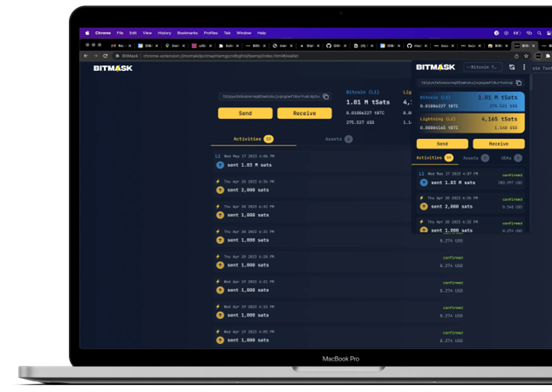
The advantages provided by BitMask include: allowing users to control their own keys, off-chain transaction validation to protect privacy, and multi-signature security to prevent theft or loss. It offers convenience without compromising privacy or control over funds. Overall, BitMask targets users who prioritize higher security and privacy compared to traditional centralized web wallets and is one of the earliest and most significant contributors to the RGB protocol.
https://linktr.ee/bitmaskwallet
RGB Explorer------RGBex
Supports searching RGB smart contracts on Bitcoin and the Lightning Network by code/asset name/contract ID/pattern ID/interface name.
Main features include:
- Asset interface: RGB smart contracts provide API interfaces to interact with the world through wallets, exchanges, and other software. They define the types of assets and contracts, such as tokens, NFTs, DAOs, identities, etc.
- Smart contract schemata: "Templates" for creating smart contracts and issuing assets. They allow the roles of programmers and contract/asset issuers to be separated, reducing the risks of designing contracts.
- Issuance method: RGB smart contracts can be developed in Rust using the RGB standard library.
https://rgbex.io/assets
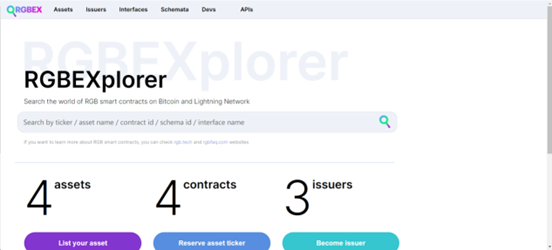
Conclusion
Although the RGB protocol is still in its early stages of development, time will tell how it provides a more reliable asset issuance solution for users compared to the more popular Bitcoin protocols centered around L2 smart contracts, leveraging Bitcoin's strong security and decentralization features. This deep integration creates a more transparent, trustless asset issuance process for users, promising greater reliability for the ecosystem. Its synergy with Bitcoin and advantages in asset issuance and DeFi make it likely to become an indispensable part of the Bitcoin ecosystem. We can look forward to how the RGB protocol will demonstrate stronger value propositions in promoting asset issuance and DeFi within the Bitcoin ecosystem, playing a more significant role and bringing more innovation and prosperity to the Bitcoin ecosystem.
References
https://github.com/LNP-BP/layer1









